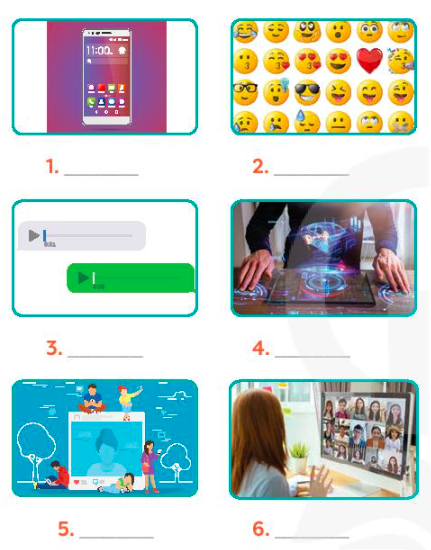Tiếng Anh 8 Unit 10 A Closer Look 1
1. Write the correct word or phrase from the box under each picture. 2. Choose the correct answer A, B, or C. 3. Complete the sentences with the words from the box. 4. Listen and repeat the words. Pay attention to the word stress. 5. Mark the stress in the underlined words. Then listen and repeat the sentences.
Bài 1
1. Write the correct word or phrase from the box under each picture.
(Viết từ hoặc cụm từ chính xác từ hộp dưới mỗi bức tranh)
voice message smartphone
social network emojis
group call holography

Phương pháp giải:
- voice message: tin nhắn thoại
- smartphone: điện thoại thông minh
- social network: mạng xã hội
- emoji: biểu tượng cảm xúc
- group call: cuộc gọi nhóm
- hologram: ảnh toàn ký
Lời giải chi tiết:
|
1. smartphone |
2. emoji |
3. voice message |
4. holography |
5. social net work |
6. group call |
Bài 2
2. Choose the correct answer A, B, or C.
(Chọn câu trả lời đúng A, B hoặc C.)
1. Many people add _____ to their text messages to express their feelings.
A. emojiis
B. words
C. letters
2. l send _____ messages when I don't feel like tybing.
A. group
B. text
C. voice
3. Many teenagers like to meet on social _____ rather than face to face.
A. television
B. networks
C. projects
4. In a _____ people in different places can join the conversation.
A. voice message
B. group call
C. system of emojis
5. By using _____, you can attend a meeting with your 3D image instead of being there in person.
A. holography
B. voice messages
C. social networks
Lời giải chi tiết:

1. Many people add emojis to their text messages to express their feelings.
(Nhiều người thêm biểu tượng cảm xúc vào tin nhắn để biểu đạt cảm xúc.)
2. I send voice messages when I don't feel like typing.
(Tôi gửi tin nhắn thoại khi tôi không muốn gõ phím.)
3. Many teenagers like to meet on social networks rather than face to face.
(Nhiều thiếu niên thích gặp mặt trên mạng xã hội hơn gặp trực tiếp.)
4. In a group call people in different places can join the conversation.
(Trong một cuộc gọi nhóm, mọi người ở những nơi khác nhau có thể tham gia cuộc trò chuyện.)
5. By using holography, you can attend a meeting with your 3D image instead of being there in person.
(Bằng cách sử dụng ảnh tưởng kí, bạn có thể tham gia cuộc họp với ảnh ba chiều thay vì phải trực tiếp đi họp.)
Bài 3
3. Complete the sentences with the words from the box.
(Hoàn thành các câu với các từ trong hộp.)
|
translation real language instantly private |
1. Do you often send ________ messages to your friends?
2. Can learning English help you overcome the ________ barrier when living abroad?
3. Telephone helps you communicate in _________ time.
4. Do you think translators will lose their jobs when _________ machines become popular?
5. Many people reply to messages ________, but others take a long time to respond.
Lời giải chi tiết:
1. Do you often send private messages to your friends?
(Bạn có thường gửi những tin nhắn bí mật cho bạn bè không?)
2. Can learning English help you overcome the language barrier when living abroad?
(Liệu việc học tiếng Anh có thể giúp bạn vượt qua rào cản ngôn ngữ khi sống ở nước ngoài không?)
3. Telephone helps you communicate in real time.
(Điện thoại để bàn giúp bạn giao tiếp trong thời gian thực?)
4. Do you think translators will lose their jobs when translation machines become popular?
(Bạn có nghỉ là các phiên dịch viên sẽ mất việc khi các máy dịch trở nên phổ biến không?)
5. Many people reply to messages instantly, but others take a long time to respond.
(Nhiều người trả lời tin nhắn ngay lập tức, nhưng số khác tốn nhiều thời gian để trả lời.)
Bài 4
4. Listen and repeat the words. Pay attention to the word stress.
(Lắng nghe và lặp lại các từ. Chú ý đến trọng âm của từ.)

Phương pháp giải:
Đối với các hậu tố -ese và -ee, bản thân nó sẽ nhận dấu trọng âm của từ.
Lời giải chi tiết:

Bài 5
5. Mark the stress in the underlined words. Then listen and repeat the sentences.
(Đánh dấu trọng âm trong các từ được gạch chân. Sau đó lắng nghe và lặp lại các câu.)
1. The interviewees said that they were Taiwanese.
2. Joe agrees with me that learning Chinese is difficult.
3. She obtained a bachelor's degree in Japanese.
4. The Taiwanese company gave each awardee a smartphone.
5. The Japanese teacher sent a video to the absentees on Monday.
Phương pháp giải:
Đối với các hậu tố -ese và -ee, bản thân nó sẽ nhận dấu trọng âm của từ.
Lời giải chi tiết:
1. The interviewees said that they were Taiwanese.
→ interviewee /ˌɪn.tə.vjuˈiː/, Taiwanese /ˌtaɪ.wəˈniːz/
(Những người đi phỏng vấn nói rằng họ là người Đài Loan.)
2. Joe agrees with me that learning Chinese is difficult.
→ Chinese /tʃaɪˈniːz/, agree /əˈɡriː/
(Joe đồng ý với tôi rằng học tiếng Trung khó.)
3. She obtained a bachelor's degree in Japanese.
→ degree /dɪˈɡriː/, Japanese /ˌdʒæp.ənˈiːz/
(Cô ấy nhận được một bằng cử nhân ở Nhật Bản.)
4. The Taiwanese company gave each awardee a smartphone.
(Công ty Đài Loan gửi mỗi người nhận giải một chiếc điện thoại thông minh.)
→ Taiwanese /ˌtaɪ.wəˈniːz/, awardee /ə.wɔːˈdiː/
5. The Japanese teacher sent a video to the absentees on Monday.
(Người giáo viên Nhật gửi một video cho những học sinh vắng mặt vào thứ Hai.)
→ Japanese /ˌdʒæp.ənˈiːz/, absentee /ˌæb.sənˈtiː/
Search google: "từ khóa + timdapan.com" Ví dụ: "Tiếng Anh 8 Unit 10 A Closer Look 1 timdapan.com"







